We introduce five strategies to improve customer experience, with lots of examples from leading brands for getting each strategy right.
Strategy No. 1 – Deeply Understand Your Customers
According to John Aves, Chief Executive at cp2experience: “The most successful companies are obsessive in their quest to deeply understand their customers. They go way beyond traditional market research and make a focus on the customer a part of everyone’s job.”
Amazon are case in point to John’s assertion, as they make focusing on customers their number-one strategy to improve customer experience. Just take a look at the following quote from Jeff Bezos.
“The number-one job of every person in this company is to focus on our customers. I’ve spent a lot of time over the last 18 months making sure people understand that our need to focus on operational efficiency does not come at the expense of the customer experience.”
Jeff Bezos, CEO of Amazon
The idea that the “number-one job of every person is to focus on the customer” is very interesting here, and this is the approach from an online business, which underlines how approaches to customer experience are changing.
But let’s take a look at a more conventional company in telephone network provider O2 and see how having a focus on their customers has improved their customer experience.
To summarize their customer experience approach Ronan Dunne, the former CEO of O2, made the following comment.
“…Every single debate about every single decision was framed around doing the right thing for the customer.”
Ronan Dunne, the former CEO of O2
From this quote, we can see that O2 were fanatical about their customers and didn’t just settle for having “satisfied” customers; they wanted their customers to be “fans”.
And why “fans” you might ask?
Well, as John says: “Fans tend to stay loyal, buy more products, services and add-ons and speak highly of a brand to their family and friends.”
If you’re a business that relies on creating great customer relationships, this is a key point, as research from the Harvard Business Review indicates that only very satisfied customers will remain loyal in today’s climate.
Satisfaction Is No Longer Enough
Take a look at the following graph, which has been adapted from the Harvard Business Review report titled “Putting the Service Profit Chain to Work”. It plots satisfaction against customer loyalty.
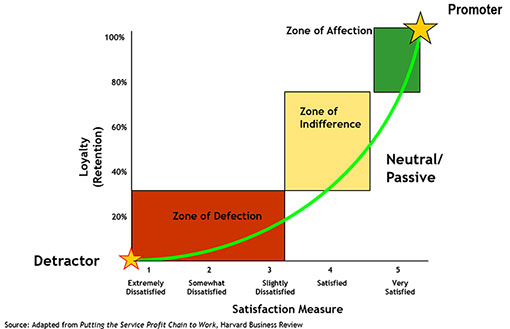
Fans sit in the green box in the graph above, and the advantage of creating these fans is that they are much less vulnerable to competitors’ offers.
“This is because many customers are emotionally committed to the brand because of the way in which O2 rewards loyalty in the form of priority access to music and sporting events,” adds John.
Customer Expectations Are Changing
We also increasingly need to focus on customers to improve customer experience because, as you will see every day in your contact centre, customers are becoming increasingly demanding. We cannot lose sight of this.
Technology is increasing the opportunities and possibilities, while research shows that trust is in decline and customers are becoming less loyal. Just look at the eight points included in the graphic below.
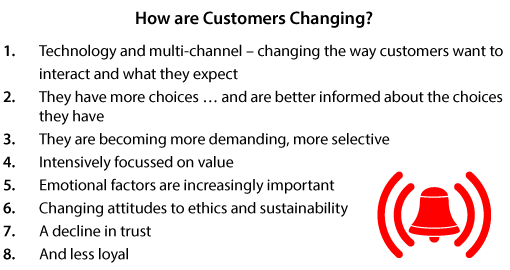
Each of these points highlights the increasing importance of focusing on customers, and even if we think that we are doing well, chances are that it’s not enough to improve customer experience enough to generate loyalty.
According to Entrepreneur Magazine, 80% of companies say they deliver “superior” service, but customers aren’t seeing it in the same way. In fact, only 8% of customers agree, as per the same article.
In the contact centre, many of the reasons for this divide come down to classic problems, such as:
- Time on hold
- Frustration at multi-layered IVRs
- Failure to resolve problem on first call
- Customer cut off or lost
- Customers having to tell their story repeatedly!
- Poorly trained employees
For advice on how to overcome common challenges like these and others, listen to the following episode of The Contact Centre Podcast with Jo Hale: Top Contact Centre Problems and How to Solve Them.
The Contact Centre Podcast – Episode 13:
Top Contact Centre Problems And How To Solve Them
For more information on this podcast visit Podcast – Top Contact Centre Problems and How To Solve Them
Is Your Customer Focus Good Enough to Improve Customer Experience?
After discussing each strategy in this article, we are going to present some questions – as put forward by John Aves – that will be useful as you think about your customer strategy.
To assess how good your customer focus is and how well you know your customers, below are four questions to ask yourself.
If you can confidently answer “yes” to each of these questions, chances are that you are in a good place.
- Do you know who your most profitable customers are?
- Do you know the factors that drive the buying behaviour and loyalty of your customers?
- Do you know how your organization is performing against these loyalty drivers?
- …And how your competitors are performing?
Strategy No. 2 – Focus on Your People
“In the same way that customer loyalty has to be earned, employees have choices too. They can stay and go the extra mile or leave – in the same way that customers can,” says John.
Does your organization genuinely focus on its people in order to earn their loyalty, or just pay lip service?
From John’s point here, an interesting question arises: does your organization genuinely focus on its people in order to earn their loyalty, or just pay lip service?
This is an interesting question to consider as your customer service play a huge role in efforts to improve customer experience.
In fact, according to a Harvard Business Review article titled “Learning from Customer Defections”, 70% of customers defecting from one supplier to another did so because they were disappointed with the service they received.
Combining this with the fact that shortcomings in the product and concerns over price together accounted for the other 30%, makes it clear just how important your people can be.
As John says: “Your people really are your brand when it comes to representing you in the marketplace.”
This view is reinforced by a couple more pieces of research by Ipsos MORI and IBM, as presented in the graphic below:
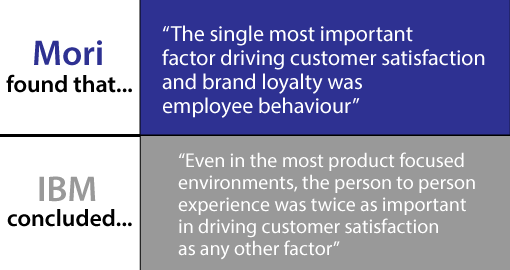
When we consider research like this, it really does support the notion that people are the drivers of improving customer experience, despite advances in new technologies and artificial intelligence (AI).
How O2 Focus on Their People
O2 is one company that makes a point of trying to improve customer experience by focusing on its people. The company realized that in order to turn customers into fans it first needed to turn its employees into fans.
So, O2 decided to get really serious about its commitment to employees, talking to hundreds of managers and colleagues to develop its People Promise, which mapped out the key stages in an employee’s career with O2.
Just take a look at the graphic below, which was developed by O2, in the creation of its People Promise.
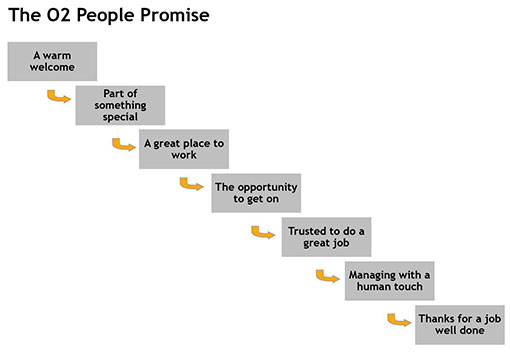
With this framework, O2 mapped the journey of employees and set the standards of performance that they expect from the organization.
In fact, John tells us: “Managers had their performance partially assessed on their success in delivering the People Promise for their teams, with this being measured, tracked and used as a key input to manager performance reviews and bonus awards.”
What better incentive is there for managers to make sure that they better support and equip their people to deliver an improved customer experience?
For more advice from John on improving employee engagement, but specifically in the contact centre, read our article: How to Improve Agent Engagement
Is Your People Focus Good Enough to Improve Customer Experience?
Here are John’s four questions for you to consider when assessing your customer experience strategy, which will perhaps shed some light on where you can do more to support your people in supporting your customers.
- Are you focusing on the employee experience to drive commitment, enthusiasm and pride?
- Do you have a two-way communication process that supports the customer agenda?
- Are you training your people to deliver on the customer experience ?
- Have you aligned the performance management system with the customer experience?
Strategy No. 3 – Implement a Differentiated Customer Experience
“Armed with knowledge of what your most important customers value (strategy 1) and with a loyal group of employees (strategy 2), the goal of this strategy is to design and implement a customer experience that differentiates your company from competitors,” says John.
When making this assertion, John was also keen to stress that standing out is about being different – but it has to be in a way that is valued by customers. This is why having a deep knowledge of your customers, and what drives their loyalty, is so important.
To stress this point, let’s take a close look at the following graph, which shows three clear phases in customer experience integrity.
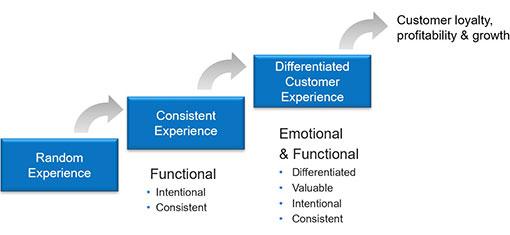
Most brands are at this stage of creating a consistent experience. To get this far they’ve had to design all aspects of the customer experience at every customer touchpoint so that customers receive a predictable experience.
This is a first, important, step to improve customer experience. However, the consistent delivery of functional requirements does not create competitive advantage – it doesn’t create fans. We also need to recognize the importance of customer emotion.
As John says: “A differentiated customer experience delivers against customers’ functional and emotional needs in a way that reinforces the brand and differentiates the company from competitors.”
“That’s the way to drive true loyalty – to create fans in the way that O2 and many other leading companies have done.”
But how can we meet customers’ emotional needs to provide an experience that differentiates your company? Well, let’s see how some leading brands have managed to do so.
The IKEA Instore Customer Experience Curve
No company can be perfect at every customer touchpoint and there is no point investing the resources to become a ten out of ten experience at a touchpoint where the customer is perfectly happy with a seven.
Again, this is why the first strategy, of focusing on really knowing your customers, is so important.
IKEA understands this very well as it focuses the high points around experiencing the product, price and the canteen to allow weary shoppers to refuel.
This can be seen in the following graph, which highlights where, through customer research, IKEA believed their time was best spent in improving customer experience.
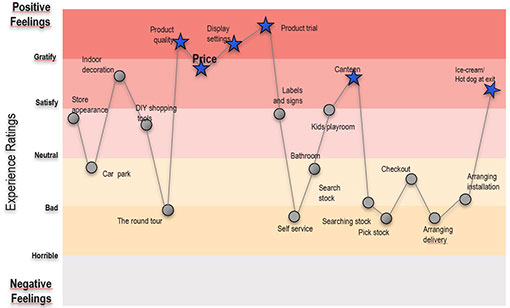
From this chart, we can also see that IKEA do not over-invest in store layout, the checkout and other aspects that they believe are much less important to their target customers.
“Deciding where to ‘over-index’ and where not to comes from an in-depth knowledge of your target customers,” says John.
“This is a knowledge of their functional needs and the opportunities for emotional connection – and a real clarity about what you want your brand to stand for.”
The Story Behind How First Direct Deliver a Differentiated Customer Experience
Some years ago Midland Bank in the UK carried out some research with their most profitable customers. These customers were mid-market consumers and they were asked to say what they wanted from their bank.
The customers said they wanted three things:
- Convenience – being able to bank 24 x 7 anywhere
- Personal service – they know me and treat me as an individual
- Competitive products – they offer me competitive products that meet my needs
The result was First Direct, a telephone and online bank. Midland created the experience and then created the brand – First Direct – to communicate it, before building a stronger brand around it.
Many of you will be familiar with the First Direct success story. The bank continues to top the numerous customer service and best place to work awards that are granted every year.
So what’s the lesson here?
According to Peter Simpson, the former Commercial Director at First Direct: “What First Direct did was to realize that people were changing their habits and would want to bank 24 hours a day, seven days a week. So that was the insight, …. I think that all great brands have insight.”
Is Your Contact Centre Designed to Improve Customer Experience?
John’s following four questions will help you to assess whether or not you have ‘designed’ your contact centre to deliver a differentiated customer experience.
- Do you understand what kind of experience will drive customers to be loyal?
- Is your call centre transaction or customer focused?
- Do your processes and technology support your customer experience?
- Are you equipping your people to deliver your customer experience – both functional and emotional?
For more on using customer emotions to improve customer experience, read our article: Creating Memorable Customer Experiences With Emotional Intelligence
Strategy No. 4 – Measure What Matters
As John tells us: “The financial reporting systems that exist in all companies to track revenue, count costs and manage cash – important though they are – do not help us measure customer loyalty.”
We need more specific measures that tell us how our decisions and subsequent actions are impacting our goal to improve customer experience and create great relationships with customers.
Then we want to create a strategy to see how we can benchmark those customer experience measures to obtain lots of great actionable insights.
With this in mind, here are four measurement tips you should implement if you are looking to improve customer experience and create a loyal customer base that become your best sales team…
Tip 1 – Group Your Customers by Loyalty
This can be tricky, but if you are able to group your customers by loyalty and identify how much they contribute to profits, including word of mouth, you can gain some really great insights.
But, not only that, by grouping customers together by loyalty, customer-obsessed companies use this measure to pay particular attention to highly profitable customers who are so loyal that they drive the organization’s growth and profitability.
In fact, according to John: “In many companies, the 80:20 rule prevails, which is that 20% of customers drive 80% of revenue profits.”
To add to this point, take a look at the graph below, which has been adapted from a study by Satmetrix.
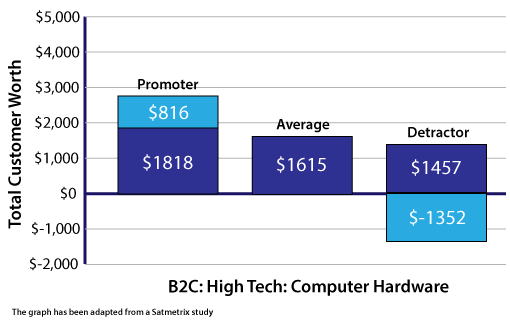
The dark blue columns show the revenue earned from different groups of customers and you can see how much more valuable promoters (or fans) are than average customers and those who are dissatisfied – the detractors.
The reality is even more dramatic when we factor in the light blue columns – which represent the word-of-mouth impact – positive in the case of promoters and negative from detractors.
The financial impact is also impressive – increasing the value of a “fan” by a further $816. And, in the case of a detractor, you can see that negative word of mouth (at $1352) wipes out almost all of the revenue earned ($1457) from customers who are unhappy.
Yet segmenting customers by levels of loyalty and calculating their full value, including the word-of-mouth impact, is rare.
Although for those companies that do, it provides a real focus on what to do to grow their base of loyal fans and therefore improve customer experience.
One company that did implement this strategy was First Direct, as they were able to calculate that 38% of their customer base is through recommendation and that they pick up a new customer every five seconds through referral.
Tip 2 – Continually Collect Feedback on the Customer Experience and How It Can Be Improved
If you have designed a unique customer experience, then it’s important for you measure your organization’s performance against the things that you want to be known for.
Other things are important – and you will want to measure those – but you crucially want to know how you are performing against the things that you really want to stand for and focus your feedback mechanisms in those key areas.
Yet, according to John: “What I see often is that the customer research efforts of many companies is an excuse for every department to ask questions they think are important – rather than what the customers say is important.”
Instead what we need to do is collect customer feedback at the critical customer touchpoints.
For ideas of how you can gather customer feedback, read our article: 25 Good Customer Feedback Examples
Tip 3 – Measure the Employee Experience
In addition to measuring customer experience, you should also measure employee experience – as our employees are so often the key in our efforts to improve customer experience.
To make the case for this and why we should measure employee experience, the following chart is a visual representation of the “service-profit” chain.

As the service profit chain – and research by others – has shown, there is a strong correlation between employee engagement/employee satisfaction and customer loyalty.
In other words. If your employees are engaged and happy, your customers will be as well.
For advice on measuring employee experience and engagement, read our article: How to Measure Employee Engagement
Tip 4 – Involve Your People in Giving Feedback
Organizations often struggle to identify problems areas within the customer experience, yet many times their people (especially their contact centre advisors) already know where the problems lie.
However, harnessing these insights is something that contact centres are traditionally very bad at doing and advisors are often not empowered or taught to think outside of the box.
There are many benefits, though, to better involving your people, as their word-of-mouth feedback can be a key way of measuring what matters.
So, get their views on what is going well and where the company needs to improve and you will see each of the following three benefits:
- They can add colour commentary to what more traditional customer research tells you
- They will have suggestions for improvement and ideas on how to solve problems
- As mentioned in the previous tip, employees who are engaged perform better and go the extra mile to help customers
For more tips on better utilizing the insights of your contact centre team, read our article: Involve Agents in Operations and Strategy
Are You Measuring What Matters to Improve Customer Experience?
Having covered four key areas in measuring customer experience, here are four related questions that will get you to think about how you can better use measures to improve customer experience within your organization.
- Have you grouped your customers by loyalty and the impact they have on your profits?
- Do you collect customer feedback at your most critical customer touchpoints?
- Are you mapping and measuring the employee experience? (advisor satisfaction surveys do not count!)
- Do you actively involve your people in getting their views on where your company needs to improve?
Strategy No. 5 – Build a Customer-Focused Culture
“The final strategy is about building customer focus into the culture, the DNA of the organization, so our efforts to improve customer experience almost become systematic,” says John.
From this, we can conclude that without embedding a customer focus into the culture, it becomes very difficult to sustain that focus.
Eventually, we want to get to a point where we move away from special customer-focused initiatives and it just becomes “the way we do things”.
We want to get to a point where we move away from special customer-focused initiatives and it just becomes “the way we do things”.
Engaging senior leaders is therefore critical, as is establishing leadership around the customer at all levels.
Just remember, people pay attention to and take notice of what they see new leaders do more than what they hear leaders say.
So having your senior people lead by example is a fundamental step in creating a customer-focused culture. Below we share even more advice for doing so, with the overall goal to improve customer experience.
Follow the Example of Leading Organizations in Terms of Culture
You will have heard the expression “Hire for attitude and values and train the skills.” We can see how this was reflected in First Direct’s approach 25 years ago, and we can still see it today.
Also, consider Zappos, the online shoe retailer in the US that recruits people who share their values, which include: delivering WOW service, pursuing growth and learning, being passionate and determined and having fun.
Then, consider Amazon, which bought Zappos in 2009. According to CNBC, the company offers $2,000 to employees who have been at the company one year, and the offer increases by $1,000 per year of tenure, maxing out at $5,000. Those who accept the offer can never work at Amazon again.
The aim of this is to only hire people who want to work for Amazon, because staying somewhere that you don’t want to work will not be healthy for either the individual or the company.
Finally, let’s examine SouthWest Airlines in the US – who are testament to the fact that low cost does not have to equal poor service.
Just take a look at the video below where Herb Kelleher, the former CEO of Southwest Airlines, discusses how his company recruits people who display a warrior’s spirit, servant’s heart and a fun-loving attitude.
Herb knew how to get things right in terms of creating a great culture, with Southwest Airlines consistently being ranked as one of the best places to work in the US.
3 More Tips on Building a Customer-Focused Culture
Here are three more tips for creating a customer-focused culture that will help to improve customer experience, as recommended by John:

John Aves
- Develop your people so they can deliver your customer experience – Ensuring you develop your team with the skills to deliver your unique experience, aligning the reward and HR systems and involving them are all key to the establishment of a customer first culture.
- Align reward and performance management systems – Linking your performance management systems around improving the customer experience is key, while also aligning this approach to both intrinsic and extrinsic rewards will incentivize delivery of the new experience.
- Involve the team in your decision-making – Engaging your employees by involving them in changes that affect customers allows them to contribute any ideas or spot things that you may have not yet considered, which may have a significant impact on customer experience.
For more tips on developing a customer-focused culture in the contact centre, read our article: Create and Maintain a Positive Culture
Is Your Culture Designed to Improve Customer Experience?
The following four questions will enable you to determine how well your culture – in the contact centre and beyond – has been structured to systematically improve customer experience.
- Are your leaders seen to be invested in promoting a customer focus?
- Do you target specific attitudes in recruitment and value them above skills?
- Have you aligned your performance management and rewards system with key customer experience goals?
- Does your team have a say in process and procedure changes that are made to improve customer experience?
In Summary
To summarize each of these five strategies, John says: “Many of them may sound obvious. They may seem like they are common sense. But, in my experience, they are not always common practice.”
Yet by combining each of these five strategies into one customer experience plan, you will form a great purpose around creating real value for customers and developing a better place to work for employees, and, implemented well, it really can drive financial success.
So, we wish you lots of good luck with your strategy and hope that many of the ideas presented in this article will be very useful for you to help improve customer experience.
For advice on how to improve customer experience, read our articles:
- How to Improve the Customer Experience – With a Checklist
- How to Reduce Friction and Add Rewards to the Customer Experience
- 18 Tried and Tested Ways to Improve the Customer Experience
Author: Robyn Coppell
Published On: 15th Apr 2020 - Last modified: 23rd Jul 2024
Read more about - Customer Service Strategy, Customer Journey, Customer Loyalty, Customer Management, CX, Editor's Picks, Employee Engagement, Jo Hale








































